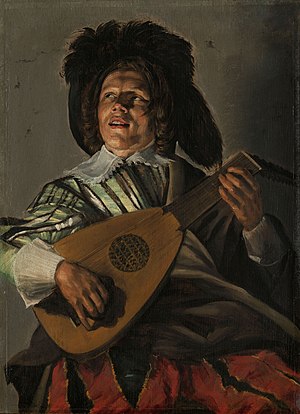
The Rijksmuseum is the national museum of the Netherlands dedicated to Dutch arts and history and is located in Amsterdam. The museum is located at the Museum Square in the borough of Amsterdam South, close to the Van Gogh Museum, the Stedelijk Museum Amsterdam, and the Concertgebouw.

Frans Hals the Elder was a Dutch Golden Age painter. He lived and worked in Haarlem, a city in which the local authority of the day frowned on religious painting in places of worship but citizens liked to decorate their homes with works of art. Hals was highly sought after by wealthy burgher commissioners of individual, married-couple, family, and institutional-group portraits. He also painted tronies for the general market.

Judith Jans Leyster was a Dutch Golden Age painter of genre works, portraits, and still lifes. Her work was highly regarded by her contemporaries, but largely forgotten after her death. Her entire oeuvre came to be attributed to Frans Hals or to her husband, Jan Miense Molenaer. In 1893, she was rediscovered and scholars began to attribute her works correctly.

Jan Six was an important cultural figure in the Dutch Golden Age.

Jan Miense Molenaer, was a Dutch Golden Age genre painter whose style was a precursor to Jan Steen's work during Dutch Golden Age painting. He shared a studio with his wife, Judith Leyster, also a genre painter, as well as a portraitist and painter of still-life. Both Molenaer and Leyster may have been pupils of Frans Hals.

Cornelis Hofstede de Groot, was a Dutch art collector, art historian and museum curator.

Wybrand Hendriks was a Dutch painter, primarily known for his portraits, and the concierge of the Teylers Museum.

The Proposition is a genre painting of 1631 by Judith Leyster, now in the Mauritshuis in The Hague, who title it Man offering money to a young woman. It depicts a woman, sewing by candlelight, as a man leans over her, touching her right shoulder with his left hand. He is offering her coins in his right hand, but she is apparently ignoring the offer and concentrating intently upon her sewing. As we see the female protagonist (seemingly) ignore the advances of her suitor, this painting has been considered to potentially be a feminist work.

The Lute Player is an oil-on-canvas painting from 1623 or 1624 now in the Louvre by the Haarlem painter Frans Hals, showing a smiling actor wearing a jester's costume and playing a lute.
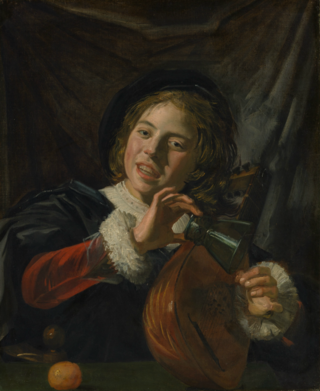
The Fingernail Test is an oil-on-canvas Dutch Golden Age painting that has been attributed to either Frans Hals or Judith Leyster, painted in 1626 and now in the Metropolitan Museum of Art, New York City.

Self-portrait by Judith Leyster is a Dutch Golden Age painting in oils now in the collection of the National Gallery of Art in Washington DC. It was offered in 1633 as a masterpiece to the Haarlem Guild of St. Luke. It was attributed for centuries to Frans Hals and was only properly attributed to Judith Leyster upon acquisition by the museum in 1949. The style is indeed comparable to that of Hals, Haarlem's most famous portraitist.
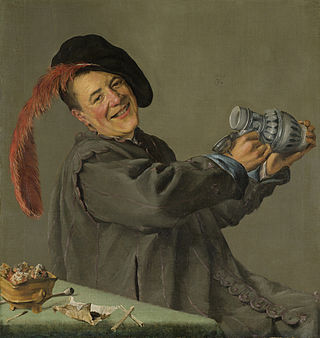
The Jolly Toper is a 1629 oil painting by the Dutch artist Judith Leyster in the collection of the Rijksmuseum that is on long-term loan to the Frans Hals Museum since 1959. It was acquired by the museum as a painting by Frans Hals and was attributed to Leyster by the researcher Juliane Harms in 1927.

The Merry Trio is an oil painting created in 1629 by the Dutch Golden Age painter Judith Leyster. It is now in a private collection. It was considered a work by Frans Hals until 1903.

The Last Drop is a c. 1629 oil painting by Judith Leyster in the John G. Johnson collection of the Philadelphia Museum of Art. It was regarded as a work by Frans Hals until 1903, when it was noticed that it is signed 'JL*' on the tankard.

A Youth with a Jug is a 1633 oil painting by Judith Leyster currently in a private collection.
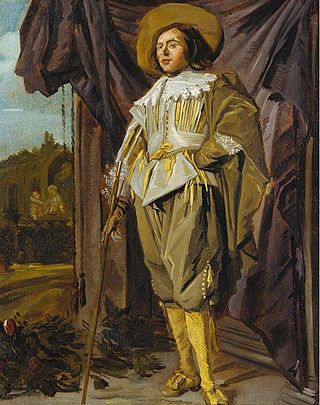
Standing Cavalier is a painting by Judith Leyster in the Royal Collection. It is the only painting by Leyster with a provenance that reaches back to the 18th-century.

Young man playing the lute is an oil painting executed in 1624 by the Dutch Golden Age artist Judith Leyster. It is now in the collection of the Rijksmuseum, and is a period copy of the same subject by Frans Hals. It was acquired by the museum as a painting by Frans Hals and was skipped by the researcher Juliane Harms in 1927, being finally attributed to Leyster by Seymour Slive in 1974.

Still Life with Flowers on a Marble Slab is a 1716 floral painting by Rachel Ruysch. It is in the collection of the Rijksmuseum, in Amsterdam.
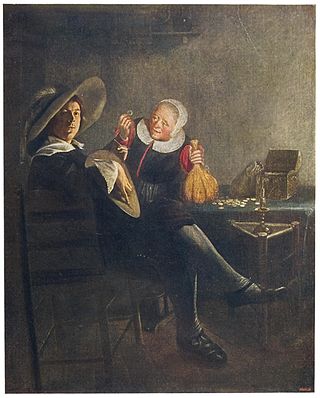
Unequal Love is a painting made in about 1631 by the Dutch Golden Age painter Judith Leyster. It is in the collection of the Galleria Nazionale d'Arte Antica, Rome.
Anna Tummers is a Dutch art historian, curator, and researcher, known for her work on Dutch Golden Age painting and Flemish painting, particularly those of the seventeenth century. She is a professor in Early Modern Art at Ghent University.
